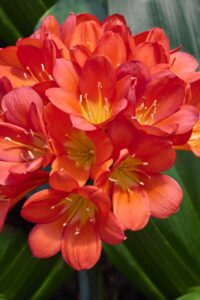
I have been enchanted by Clivia miniata, which usually just goes by “clivia”, or sometimes “fire lily”, for a long time. A few years ago, I succumbed and bought a clivia from a vendor at the Philadelphia Flower show. I brought it home, put it in a choice location beside the other house plants on my dining room window seat and waited. And waited, and waited. It has not died, and, in fact, appears to be in excellent health, but it has never bloomed.
I occasionally raise my fists to the heavens and shout, “Why?!?”
Clivias are tender plants, related to Hippeastrum, commonly known as amaryllis, a favorite holiday bloomer. You can see that relationship in the long, strappy leaves and tall stalks that are typical of both genera. The average clivia grows between eighteen to twenty-four inches tall. Instead of the single, giant trumpet-shaped flowers that appear on amaryllis, clivia bear large, somewhat rounded flowerheads composed of groups of multiple smaller trumpets. Clivia miniata has become the most popular clivia because it is the only one of the five clivia species with upward-facing flowers. Brilliant orange is the dominant flower color, but breeders have developed brick red, yellow and peach strains as well as varieties with variegated leaves. Like amaryllis, clivia is a tender plant, and must be brought inside in areas where winter temperatures fall below freezing.
My non-bloooming clivia and its relatives were named in honor of an Englishwoman, Lady Charlotte Florentia Clive, wife of an early nineteenth century Duke of Northumberland. Like pelargoniums, gerbera daisies and many of the other showy species that we now take for granted, clivia is native to South Africa. During the colonial period it migrated to Europe, and the first plants to bloom in England did so in 1827 in a greenhouse at Syon House, residence of the Northumberlands. The plants had been discovered in South Africa only a few years earlier.
The Clive’s plant had orange flowers. The much rarer yellow-flowered form of C. miniata was not discovered until 1888, in the Natal region of South Africa. Like the original orange-flowered clivia, the yellow-flowered form became a “must have” for wealthy plant collectors. Clivia caught on during the Victorian period, becoming a fixture in conservatories and greenhouses. In the second half of the twentieth century breeders in the U.S., Asia and elsewhere concentrated on enlarging the number of forms and colors. Longwood Gardens, the renowned horticultural institution in Kennett Square, Pennsylvania, has been a leader in the effort. Breeding great market-worthy hybrids usually involves years of work by skilled horticulturists, but amateurs can also succeed on a smaller scale, as the plants hybridize readily.
Getting back to my clivia dilemma and my raised fists… I set out to explore the possible reasons for my failure. The plant is pot-bound, which is a positive factor, as clivias like the coziness of close quarters. It gets relatively little water, but probably needs even less. The soil mix is well drained, another requirement, though I may repot and mix with some shredded bark to increase drainage even more. What my clivia has not gotten is the defined chilling period that induces bud formation. Experts say that clivias should be given a dormancy period of about 35 days at temperatures between 55 and 35 degrees Fahrenheit. Translated into human terms, that means living conditions that are colder than the average house and warmer than the average refrigerator. I think my unheated garage should suffice, as long as I provide myself with plenty of reminders about checking the plant, adding a few drops of water periodically, and relocating it if the temperature drops below 35.
Several sources point to the fact that the chilling/dormancy period is useful for stimulating bud formation at a specific time, but if that dormancy does not take place, the clivia will flower on its own later in the year. This has clearly not happened with my plant.
So what is going on? The only other explanation for the non-flowering phenomenon is that my plant is too young. It takes between two and five years for a clivia to produce its first batch of flowers. My plant was relatively inexpensive when I bought it, so it was probably quite young. It may be that all I need is patience, which is a basic requirement for successful gardening.
I have plenty of patience, not to mention a busy life, which is sometimes a cheap substitute for patience. Many of my garden plants have waited several years to flower, and I haven’t noticed until an unexpected burst of blooms surprises me. Usually I call that a miracle, because that is a much more face-saving explanation than “I forgot all about it.”
So, I will wait for my clivia to get older, but I will also give it a dormancy period in the hopes of pushing things along.
Many garden centers and florists carry clivia. If you spend a little extra, you can purchase an older plant that is already sporting flower buds. If you do, you will almost certainly be ahead of me and my clivia. A good mail order source is Logee’s Greenhouses, Ltd., 141 North Street, Danielson, CT 06239; (888) 330-8038; www.logees.com. Print catalog available.
